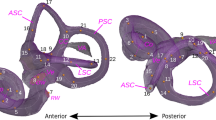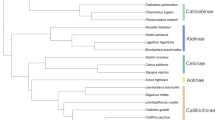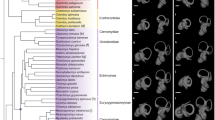Abstract
Several detailed studies of the external morphology of the ear region in extinct sloths have been published in the past few decades, and this anatomical region has proved extremely helpful in elucidating the phylogenetic relationships among the members of this mammalian clade. Few studies of the inner ear anatomy in these peculiar animals were conducted historically, but these are increasing in number in recent years, in both the extinct and extant representatives, due to wider access to CT-scanning facilities, which allow non-destructive access to internal morphologies. In the present study, we analyze the extinct ground sloth Glossotherium robustum and provide a description of the external features of the ear region and the endocranial side of the petrosal bone, coupled with the first data on the anatomy of the bony labyrinth. Some features observable in the ear region of G. robustum (e.g., the shape and size of the entotympanic bone and the morphology of the posteromedial surface of the petrosal) are highly variable, both intraspecifically and intraindividually. The form of the bony labyrinth of G. robustum is also described, providing the first data from this anatomical region for the family Mylodontidae. The anatomy of the bony labyrinth of the genus Glossotherium is here compared at the level of the superorder Xenarthra, including all available extant and extinct representatives, using geometric morphometric methods. In light of the new data, we discuss the evolution of inner ear anatomy in the xenarthran clade, and most particularly in sloths, considering the influence of phylogeny, allometry, and physiology on the shape of this highly informative region of the skull. These analyses show that the inner ear of Glossotherium more closely resembles that of the extant anteaters, and to a lesser extent those of the giant ground sloth Megatherium and euphractine armadillos, than those of the extant sloths Bradypus and Choloepus, further demonstrating the striking morphological convergence between the two extant sloth genera.









Similar content being viewed by others
Abbreviations
- FMNH:
-
Field Museum of Natural History (Chicago, USA)
- FUESMEN:
-
Fundación Escuela de Medicina Nuclear (Mendoza, Argentina)
- MACN Pv:
-
Colección de Paleontología de Vertebrados, Museo Argentino de Ciencias Naturales “Bernardino Rivadavia” (Buenos Aires, Argentina)
- MLP:
-
División Paleontología de Vertebrados, Museo de La Plata (La Plata, Argentina)
- ROM:
-
Royal Ontario Museum (Toronto, Canada)
References
Ameghino F (1902) Notas sobre algunos mamíferos fósiles, nuevos ó poco conocidos del valle de Tarija. Anales Mus Nac Hist Nat Buenos Aires 8:225–261
Bargo MS, Toledo N, Vizcaíno SF (2006) Muzzle of south American Pleistocene ground sloths (Xenarthra, Tardigrada). J Morphol 267:248–263
Bargo MS, Vizcaíno SF (2008) Paleobiology of Pleistocene ground sloths (Xenarthra, Tardigrada): biomechanics, morphogeometry and ecomorphology applied to the masticatory apparatus. Ameghiniana 45(1):175–196
Benoit J, Essid EM, Marzougui W, Ammar HK, Lebrun R, Tabuce R, Marivaux L (2013) New insights into the ear region anatomy and cranial blood supply of advanced stem Strepsirhini: evidence from three primate petrosals from the Eocene of Chambi, Tunisia. J Hum Evol 65(5):551–572
Berlin JC, Kirk EC, Rowe TB (2013) Functional implications of ubiquitous semicircular canal non-orthogonality in mammals. PLoS One 8(11):e79585
Billet G, Hautier L, Asher RJ, Schwarz C, Crumpton N, Martin T, Ruf I (2012) High morphological variation of vestibular system accompanies slow and infrequent locomotion in three-toed sloths. Proc R Soc B 279:3932–3939
Billet G, Germain D, Ruf I, de Muizon C, Hautier L (2013) The inner ear of Megatherium and the evolution of the vestibular system in sloths. J Anat 223(6):557–567
Billet G, Hautier L, Lebrun R (2015a) Morphological diversity of the bony labyrinth (inner ear) in extant xenarthrans and its relation to phylogeny. J Mammal 96(4):658–672
Billet G, de Muizon C, Schellhorn R, Ruf I, Ladevèze S, Bergqvist L (2015b) Petrosal and inner ear anatomy and allometry amongst specimens referred to Litopterna (Placentalia). Zool J Linn Soc 173(4):956–987
Blanco RE, Rinderknecht A (2008) Estimation of hearing capabilities of Pleistocene ground sloths (Mammalia, Xenarthra) from middle-ear anatomy. J Vertebr Paleontol 28(1):274–276
Blanco RE, Rinderknecht A (2012) Fossil evidence of frequency range of hearing independent of body size in South American Pleistocene ground sloths (Mammalia, Xenarthra). C R Palevol 11(8):549–554
Clack AA, MacPhee RD, Poinar HN (2012) Mylodon darwinii DNA sequences from ancient fecal hair shafts. Ann Anat 194(1):26–30
Cope ED (1889) The Edentata of North America. Am Nat 23(272):657–664
Coutier F, Hautier L, Cornette R, Amson E, Billet G (2017) Orientation of the lateral semicircular canal in Xenarthra and its links with head posture and phylogeny. J Morphol 278(5):704–717
Danilo L, Remy J, Vianey-Liaud M, Mérigeaud S, Lihoreau F (2015) Intraspecific variation of endocranial structures in extant Equus: a prelude to endocranial studies in fossil equoids. J Mamm Evol 22(4):561–582
David R, Droulez J, Allain R, Berthoz A, Janvier P, Bennequin D (2010) Motion from the past. A new method to infer vestibular capacities of extinct species. C R Palevol 9(6):397–410
David R, Stoessel A, Berthoz A, Spoor F, Bennequin D (2016) Assessing morphology and function of the semicircular duct system: introducing new in-situ visualization and software toolbox. Sci Rep 6:32772
De Iuliis G (2017) Recent progress and future prospects in fossil xenarthran studies, with emphasis on current methodology in sloth taxonomy. J Mamm Evol DOI. https://doi.org/10.1007/s10914-017-9407-8
De Iuliis G, Gaudin TJ, Vicars M (2011) A new genus and species of Nothrotheriid sloth (Xenarthra, Tardigrada, Nothrotheriidae) from the Late Miocene (Huayquerian) of Peru. Palaeontology 54(1):171–205
De Iuliis G, Cartelle C, McDonald HG, Pujos F (2017) The mylodontine ground sloth Glossotherium tropicorum from the Late Pleistocene of Ecuador and Peru. Pap Palaeontol 3:613–636
Delsuc F, Catzeflis FM, Stanhope MJ, Douzery EJ (2001) The evolution of armadillos, anteaters and sloths depicted by nuclear and mitochondrial phylogenies: implications for the status of the enigmatic fossil Eurotamandua. Proc R Soc B 268(1476):1605–1615
Ekdale EG (2013) Comparative anatomy of the bony labyrinth (inner ear) of placental mammals. PLoS One 8(6):e66624
Ekdale EG (2016) Form and function of the mammalian inner ear. J Anat 228(2):324–337
Ekdale EG, Racicot RA (2015) Anatomical evidence for low frequency sensitivity in an archaeocete whale: comparison of the inner ear of Zygorhiza kochii with that of crown Mysticeti. J Anat 226(1):22–39
Ekdale EG, Rowe T (2011) Morphology and variation within the bony labyrinth of zhelestids (Mammalia, Eutheria) and other therian mammals. J Vertebr Paleontol 31(3):658–675
Esteban GI (1996) Revisión de los Mylodontinae cuaternarios (Edentata-Tardigrada) de Argentina, Bolivia y Uruguay. Sistemática, filogenia, paleobiología, paleozoogeografía y paleoecología. Dissertation, Universidad Nacional de Tucumán
Fariña RA, Vizcaíno SF, Bargo MS (1998) Body mass estimations in Lujanian (late Pleistocene-early Holocene of South America) mammal megafauna. Mastozool Neotrol 5(2):87–108
Fariña RA, Vizcaíno SF (2003) Slow moving or browsers? A note on nomenclature. Senckenb Biol 83(1):3–4
Fernicola JC, Vizcaíno SF, De Iuliis G (2009) The fossil mammals collected by Charles Darwin in South America during his travels on board the HMS Beagle. Rev Asoc Geol Argent 64(1):147–159
Flower W (1883) On the arrangement of the orders and families of existing Mammalia. Proc Zool Soc Lond 1883:178–186
Gaudin TJ (1995) The ear region of edentates and the phylogeny of the Tardigrada (Mammalia, Xenarthra). J Vertebr Paleontol 15(3):672–705
Gaudin TJ (2004) Phylogenetic relationships among sloths (Mammalia, Xenarthra, Tardigrada): the craniodental evidence. Zool J Linnean Soc 140(2):255–305
Gaudin TJ (2011) On the osteology of the auditory region and orbital wall in the extinct west Indian sloth genus Neocnus Arredondo, 1961 (Placentalia, Xenarthra, Megalonychidae). Ann Carnegie Mus 80(1):5–28
Gaudin TJ, Biewener AA (1992) The functional morphology of xenarthrous vertebrae in the armadillo Dasypus novemcinctus (Mammalia, Xenarthra). J Morphol 214(1):63–81
Gaudin TJ, Wible JR (2006) The phylogeny of living and extinct armadillos (Mammalia, Xenarthra, Cingulata): a craniodental analysis. In: Carrano MT, Gaudin TJ, Blob RW, Wible JR (eds) Amniote paleobiology: perspectives on the evolution of mammals, birds and reptiles. University of Chicago Press, Chicago, pp 153–198
Gaudin TJ, Croft DA (2015) Paleogene Xenarthra and the evolution of South American mammals. J Mammal 96(4):622–634
Gaudin TJ, De Iuliis G, Toledo N, Pujos F (2015) The basicranium and orbital region of the early Miocene Eucholoeops ingens Ameghino, (Xenarthra, Pilosa, Megalonychidae). Ameghiniana 52(2):226–240
Gill T (1872) Arrangement of the families of mammals, with analytical tables. Smithson Misc Collect 11:1–98
Gosselin-Ildari AD (2006) Functional morphology of the bony labyrinth in primates. The University of Texas at Austin, Dissertation
Greenwood AD, Castresana J, Feldmaier-Fuchs G, Pääbo S (2001) A molecular phylogeny of two extinct sloths. Mol Phylogenet Evol 18(1):94–103
Guth C (1961) La région temporale des Edentés. Université de Paris, Dissertation
Illiger K (1811) Prodromus systematis mammalium et avium. C. Salfeld, Berlin
Jones MG, Spells KE (1963) A theoretical and comparative study of the functional dependence of the semicircular canal upon its physical dimensions. Proc R Soc B 157(968):403–419
van der Klaauw CJ (1931) On the tympanic region of the skull in the Mylodontidae. Proc Zool Soc Lond 1931:607–655
Lebrun R (2008) Evolution and development of the strepsirrhine primate skull. Université Montpellier II and University of Zürich, Dissertation
Lebrun R (2014) ISE-MeshTools software. http://morphomuseum.com/meshtools
Lebrun R, de León MP, Tafforeau P, Zollikofer C (2010) Deep evolutionary roots of strepsirrhine primate labyrinthine morphology. J Anat 216(3):368–380
Linnaeus C (1758) Systema naturae per regna tria naturae, secundum classes, ordines, genera, species, cum characteribus, differentiis, synonymis, locis, 10th edn, vol 1. Holmiae, Stockholm
Lydekker R (1894) The extinct edentates of Argentina. An Mus La Plata 3(2):1–118
Macrini TE, Flynn JJ, Ni X, Croft DA, Wyss AR (2013) Comparative study of notoungulate (Placentalia, Mammalia) bony labyrinths and new phylogenetically informative inner ear characters. J Anat 223(5):442–461
Malinzak MD, Kay RF, Hullar TE (2012) Locomotor head movements and semicircular canal morphology in primates. Proc Natl Acad Sci U S A 109(44):17914–17919
Manoussaki D, Chadwick RS, Ketten DR, Arruda J, Dimitriadis EK, O'Malley JT (2008) The influence of cochlear shape on low-frequency hearing. Proc Natl Acad Sci U S A 105(16):6162–6166
McAfee RK (2009) Reassessment of the cranial characters of Glossotherium and Paramylodon (Mammalia: Xenarthra: Mylodontidae). Zool J Linnean Soc 155(4):885–903
McKenna MC, Bell SK (1997) Classification of mammals above the species level. Columbia University Press, New York
Mones A (1986) Palaeovertebrata Sudamericana. Catálogo sistemático de los vertebrados fósiles de América del Sur. Parte I. Lista preliminar y bibliografía. Cour Forsch Inst Senckenberg 82:1–625
Muller M (1999) Size limitations in semicircular duct systems. J Theor Biol 198(3):405–437
Nyakatura JA (2012) The convergent evolution of suspensory posture and locomotion in tree sloths. J Mamm Evol 19(3):225–234
Orliac MJ, Benoit J, O'Leary MA (2012) The inner ear of Diacodexis, the oldest artiodactyl mammal. J Anat 221(5):417–426
Orliac MJ, O’Leary MA (2016) The inner ear of Protungulatum (pan-Euungulata, Mammalia). J Mamm Evol 23(4):337–352
Owen FRS (1840) Fossil Mammalia. In: Darwin C (ed) The zoology of the voyage of the Beagle. Smith, Elder and Co., London, pp 13–111
Owen FRS (1842) Description of the skeleton of an extinct gigantic sloth, Mylodon robustus, Owen, with observations on the osteology, natural affinities, and probable habits of the megatheroid quadrupeds in general. Direction of the Council, London
Patterson B, Segall W, Turnbull WD (1989) The ear region in xenarthrans (= Edentata: Mammalia). Part I. Cingulates. Fieldiana Geol 18:1–46
Patterson B, Turnbull WD, Segall W, Gaudin TJ (1992) The ear region in xenarthrans (= Edentata: Mammalia). Part II. Pilosa (sloths, anteaters), palaeanodonts, and a miscellany. Fieldiana Geol 24:1–78
Perier A, Lebrun R, Marivaux L (2016) Different level of intraspecific variation of the bony labyrinth morphology in slow- versus fast-moving primates. J Mamm Evol 23(4):353–368
Pitana VG, Esteban GI, Ribeiro AM, Cartelle C (2013) Cranial and dental studies of Glossotherium robustum (Owen, 1842) (Xenarthra: Pilosa: Mylodontidae) from the Pleistocene of southern Brazil. Alcheringa 37(2):147–162
Pujos F, De Iuliis G (2007) Late Oligocene Megatherioidea Fauna (Edentata: Xenarthra) from Salla-Luribay (Bolivia): new data on basal sloth radiation and Cingulata-Phyllophaga split. J Vertebr Paleontol 27(1):132–144
Pujos F, De Iuliis G, Cartelle C (2017) A paleogeographic overview of tropical fossil sloths: towards an understanding of the origin of extant suspensory sloths? J Mamm Evol 24(1):1–20
Pujos F, Gaudin TJ, De Iuliis G, Cartelle C (2012) Recent advances on variability, morpho-functional adaptations, dental terminology, and evolution of sloths. J Mamm Evol 19(3):159–169
Ruf I, Volpato V, Rose KD, Billet G, de Muizon C (2016) Digital reconstruction of the inner ear of Leptictidium auderiense (Leptictida, Mammalia) and north American leptictids reveals new insight into leptictidan locomotor agility. PalZ 90(1):153–171
Silcox MT, Bloch JI, Boyer DM, Godinot M, Ryan TM, Spoor F, Walker A (2009) Semicircular canal system in early primates. J Hum Evol 56(3):315–327
Sipla JS, Spoor F (2008) The physics and physiology of balance. In: Thewissen JGM, Nummela S (eds) Sensory evolution on the threshold: adaptations in secondarily aquatic vertebrates. University of California Press, Berkeley and Los Angeles, pp 227–232
Slater GJ, Cui P, Forasiepi AM, Lenz D, Tsangaras K, Voirin B, de Moraes-Barros N, MacPhee RDE, Greenwood AD (2016) Evolutionary relationships among extinct and extant sloths: the evidence of mitogenomes and retroviruses. Genome Biol Evol 8(3):607–621
Specht M (2007) Spherical surface parameterization and its application to geometric morphometric analysis of the braincase. University of Zürich, Dissertation
Specht M, Lebrun R, Zollikofer CPE (2007) Visualizing shape transformation between chimpanzee and human braincases. Vis Comput 23(9):743–751
Spoor F, Garland T, Krovitz G, Ryan TM, Silcox MT, Walker A (2007) The primate semicircular canal system and locomotion. Proc Natl Acad Sci U S A 104(26):10808–10812
Toledo N (2016) Paleobiological integration of Santacrucian sloths (early Miocene of Patagonia). Ameghiniana 53(2):100–141
Varela L, Tambusso PS, Fariña RA (2016) Inner and middle ear 3D reconstruction of the extinct giant sloth Lestodon armatus. ICVM-11 abstracts, Washington DC
Vizcaíno SF, Zárate M, Bargo MS, Dondas A (2001) Pleistocene burrows in the mar del Plata area (Argentina) and their probable builders. Acta Palaeontol Pol 46(2):289–301
Wible JR (2010) Petrosal anatomy of the nine-banded armadillo, Dasypus novemcinctus Linnaeus, 1758 (Mammalia, Xenarthra, Dasypodidae). Ann Carnegie Mus 79(1):1–28
Wible JR, Gaudin TJ (2004) On the cranial osteology of the yellow armadillo Euphractus sexinctus (Dasypodidae, Xenarthra, Placentalia). Ann Carnegie Mus 73(3):117–196
Zárate MA, Bargo MS, Vizcaíno SF, Dondas A, Scaglia O (1998) Estructuras biogénicas en el Cenozoico tardío de Mar del Plata (Argentina) atribuibles a grandes mamíferos. Rev Asoc Argent Sedimentol 5(2):95–103
Acknowledgments
We are grateful to the FUESMEN institute (Fundación Escuela de Medicina Nuclear, Mendoza, Argentina) for access to CT-scanning facilities, and we are particularly indebted to Sergio Mosconi and collaborators for assistance with image processing. We thank A. Kramarz, S.M. Alvarez and L. Chornogubsky (MACN, Buenos Aires, Argentina) and M. Reguero, S.C. Scarano and M.L. de los Reyes (MLP, La Plata, Argentina), who kindly gave access to the specimens under their care. We thank the PaleoFactory Lab (Sapienza Università di Roma, Italy) for access to their facilities, without which this work would not have been possible. We also thank M. Fernández-Monescillo, S. Hernández del Pino and A. Forasiepi (IANIGLA, CCT-CONICET-Mendoza, Argenina) for their useful suggestions. This paper greatly benefited from the careful reading and thoughtful comments by the editor S. Thatje, Prof. G. De Iuliis and other two anonymous reviewers.
Funding
This research was partially funded by ECOS-FonCyT (A14U01).
Author information
Authors and Affiliations
Corresponding author
Additional information
Communicated by: Sven Thatje
Electronic supplementary materials
ESM 1
(PDF 2829 kb)
Rights and permissions
About this article
Cite this article
Boscaini, A., Iurino, D.A., Billet, G. et al. Phylogenetic and functional implications of the ear region anatomy of Glossotherium robustum (Xenarthra, Mylodontidae) from the Late Pleistocene of Argentina. Sci Nat 105, 28 (2018). https://doi.org/10.1007/s00114-018-1548-y
Received:
Revised:
Accepted:
Published:
DOI: https://doi.org/10.1007/s00114-018-1548-y




